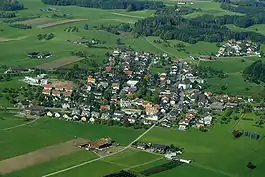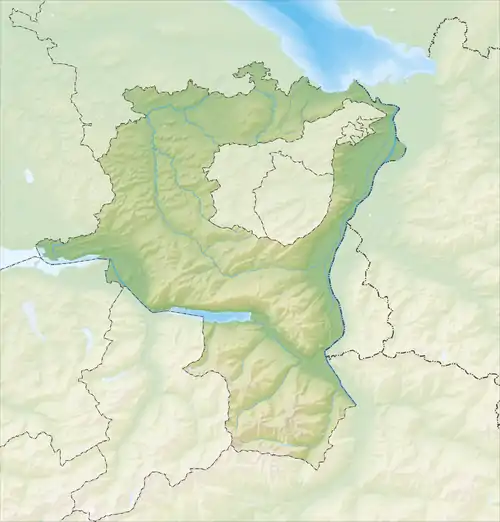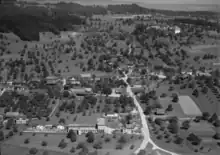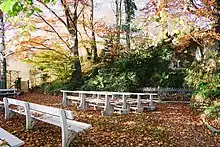Niederhelfenschwil
Niederhelfenschwil is a municipality in the Wahlkreis (constituency) of Wil in the canton of St. Gallen in Switzerland.
Niederhelfenschwil | |
|---|---|
 Niederhelfenschwil village from the air | |
 Coat of arms | |
Location of Niederhelfenschwil | |
 Niederhelfenschwil  Niederhelfenschwil | |
| Coordinates: 47°29′N 9°11′E | |
| Country | Switzerland |
| Canton | St. Gallen |
| District | Wil |
| Government | |
| • Mayor | Simon Thalmann |
| Area | |
| • Total | 16.34 km2 (6.31 sq mi) |
| Elevation | 580 m (1,900 ft) |
| Population (31 December 2018)[2] | |
| • Total | 3,149 |
| • Density | 190/km2 (500/sq mi) |
| Time zone | UTC+01:00 (Central European Time) |
| • Summer (DST) | UTC+02:00 (Central European Summer Time) |
| Postal code(s) | 9527 |
| SFOS number | 3423 |
| Surrounded by | Bischofszell (TG), Kradolf-Schönenberg (TG), Niederbüren, Oberbüren, Wuppenau (TG), Zuzwil |
| Website | www SFSO statistics |
History
Niederhelfenschwil is first mentioned in 818 as Helfolteswilare. In 1426 it was mentioned as Nidren-Helffentswile. The village of Lenggenwil was mentioned in 903 as Linkenvilare.[3]
Geography


Niederhelfenschwil has an area, as of 2006, of 16.3 km2 (6.3 sq mi). Of this area, 71.1% is used for agricultural purposes, while 19.8% is forested. Of the rest of the land, 8.4% is settled (buildings or roads) and the remainder (0.6%) is non-productive (rivers or lakes).[4]
The municipality is located in the Wil Wahlkreis, north of the Thur river between Bischofszell and Wil. It consists of the villages of Niederhelfenschwil, Lenggenwil and Schloss Zuckenriet as well as the hamlets of Enkhüseren, Dietenwil and Dägetschwil.
Coat of arms
The blazon of the municipal coat of arms is Azure between a Pall Or letters N, L and Z[5]
Demographics
Niederhelfenschwil has a population (as of 31 December 2020) of 3,181.[6] As of 2007, about 5.6% of the population was made up of foreign nationals. Of the foreign population, (as of 2000), 34 are from Germany, 16 are from Italy, 50 are from ex-Yugoslavia, 9 are from Austria, 5 are from Turkey, and 44 are from another country.[7] Over the last 10 years the population has grown at a rate of 11.6%. Most of the population (as of 2000) speaks German (97.0%), with Albanian being second most common ( 1.0%) and Portuguese being third ( 0.4%).[4] Of the Swiss national languages (as of 2000), 2,522 speak German, 2 people speak French, 8 people speak Italian, and 1 person speaks Romansh.[8]
The age distribution, as of 2000, in Niederhelfenschwil is; 475 children or 18.3% of the population are between 0 and 9 years old and 406 teenagers or 15.6% are between 10 and 19. Of the adult population, 279 people or 10.7% of the population are between 20 and 29 years old. 479 people or 18.4% are between 30 and 39, 357 people or 13.7% are between 40 and 49, and 252 people or 9.7% are between 50 and 59. The senior population distribution is 165 people or 6.3% of the population are between 60 and 69 years old, 138 people or 5.3% are between 70 and 79, there are 44 people or 1.7% who are between 80 and 89, and there are 4 people or 0.2% who are between 90 and 99.[8]
In 2000 there were 176 persons (or 6.8% of the population) who were living alone in a private dwelling. There were 464 (or 17.9%) persons who were part of a couple (married or otherwise committed) without children, and 1,847 (or 71.1%) who were part of a couple with children. There were 62 (or 2.4%) people who lived in single parent home, while there are 22 persons who were adult children living with one or both parents, 9 persons who lived in a household made up of relatives, 6 who lived household made up of unrelated persons, and 13 who are either institutionalized or live in another type of collective housing.[8]
In the 2007 federal election the most popular party was the SVP which received 45.1% of the vote. The next three most popular parties were the CVP (23.8%), the FDP (11.6%) and the SP (6.7%).[4]
In Niederhelfenschwil about 77.4% of the population (between age 25-64) have completed either non-mandatory upper secondary education or additional higher education (either university or a Fachhochschule).[4] Out of the total population in Niederhelfenschwil, as of 2000, the highest education level completed by 500 people (19.2% of the population) was Primary, while 949 (36.5%) have completed their secondary education, 274 (10.5%) have attended a Tertiary school, and 55 (2.1%) are not in school. The remainder did not answer this question.[8]
The historical population is given in the following table:[3]
| year | population |
|---|---|
| 1837 | 1,275 |
| 1850 | 1,279 |
| 1900 | 1,250 |
| 1950 | 1,469 |
| 1970 | 1,614 |
| 2000 | 2,599 |
Heritage sites of national significance

The Catholic parish church of St. John the Baptist and Zuckenriet Castle are listed as Swiss heritage sites of national significance.[9]
Economy
As of 2007, Niederhelfenschwil had an unemployment rate of 0.84%. As of 2005, there were 254 people employed in the primary economic sector and about 90 businesses involved in this sector. 228 people are employed in the secondary sector and there are 49 businesses in this sector. 286 people are employed in the tertiary sector, with 58 businesses in this sector.[4]
As of October 2009 the average unemployment rate was 2.4%.[10] There were 190 businesses in the municipality of which 42 were involved in the secondary sector of the economy while 62 were involved in the third.[11]
As of 2000 there were 487 residents who worked in the municipality, while 801 residents worked outside Niederhelfenschwil and 231 people commuted into the municipality for work.[12]
Religion
From the 2000 census, 1,798 or 69.2% are Roman Catholic, while 523 or 20.1% belonged to the Swiss Reformed Church. Of the rest of the population, there are 10 individuals (or about 0.38% of the population) who belong to the Orthodox Church, and there are 55 individuals (or about 2.12% of the population) who belong to another Christian church. There are 50 (or about 1.92% of the population) who are Islamic. There are 6 individuals (or about 0.23% of the population) who belong to another church (not listed on the census), 106 (or about 4.08% of the population) belong to no church, are agnostic or atheist, and 51 individuals (or about 1.96% of the population) did not answer the question.[8]
References
- "Arealstatistik Standard - Gemeinden nach 4 Hauptbereichen". Federal Statistical Office. Retrieved 13 January 2019.
- "Ständige Wohnbevölkerung nach Staatsangehörigkeitskategorie Geschlecht und Gemeinde; Provisorische Jahresergebnisse; 2018". Federal Statistical Office. 9 April 2019. Retrieved 11 April 2019.
- Niederhelfenschwil in German, French and Italian in the online Historical Dictionary of Switzerland.
- Swiss Federal Statistical Office accessed 20-January-2010
- Flags of the World.com Archived 2011-06-04 at the Wayback Machine accessed 20-January-2010
- "Ständige und nichtständige Wohnbevölkerung nach institutionellen Gliederungen, Geburtsort und Staatsangehörigkeit". bfs.admin.ch (in German). Swiss Federal Statistical Office - STAT-TAB. 31 December 2020. Retrieved 21 September 2021.
- Der Kanton St. Gallen und seine Menschen in Zahlen - Ausgabe 2009 (in German) accessed 30 December 2009
- Canton St. Gallen Statistics-Hauptergebnisse der Volkszählung 2000: Regionen- und Gemeindevergleich-Personen Archived 2009-10-03 at the Wayback Machine (in German) accessed 30 December 2009
- Swiss inventory of cultural property of national and regional significance Archived 2009-05-01 at the Wayback Machine 21.11.2008 version, (in German) accessed 20-Jan-2010
- St Gallen Canton statistics-Unemployment (in German) accessed 30 December 2009
- St Gallen Canton statistics-Businesses Archived 2011-07-07 at the Wayback Machine (in German) accessed 31 December 2009
- St Gallen Canton statistics-Commuters Archived 2009-07-22 at the Wayback Machine (in German) accessed 31 December 2009
External links
- Official website (in German)